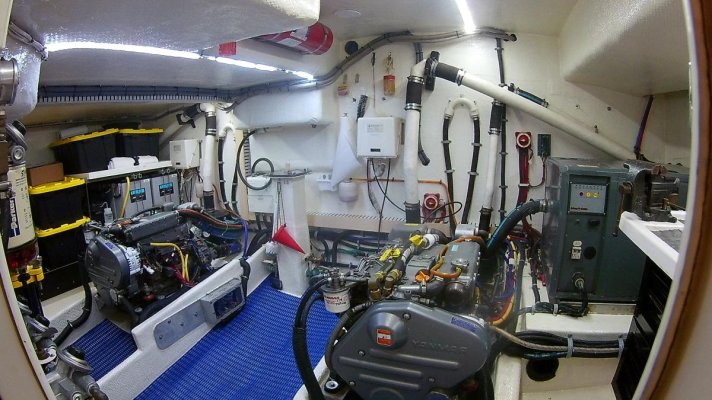Frank60
Veteran Member
- Joined
- Mar 16, 2020
- Messages
- 53
- Location
- United States
- Vessel Name
- About Time
- Vessel Make
- Meridian 368
We're in the early planning stages of selling our boat on the lake and buying a boat on the southeast coast. As I'm looking at boats for sale to get myself educated on options, I'm leaning towards a trawler.
The thing that I can't figure out is the wide range of power for similar size boats. I'm scratching my head a bit at how some of these boats would even move in a headwind. So I'm clearly misunderstanding something and hoping someone can set me straight.
For reference, my current boat is 38 feet, 27,000 pounds, and has two 420 hp MerCruiser gasoline engines. It's a planing hull and can go pretty fast if I want to burn some fuel. But, I don't normally cruise at more than 8 to 10 kts.
As I'm looking at trawlers, I see some with similar size (diesel) engines to my current boat. For example, a Grand Banks Europa 42, 43,000 pounds, with two 420 hp Caterpillar engines. On the other end of the spectrum is a DeFever (49) weighing 54,000 pounds with two 150 hp John Deere engines. Or, a Selene 40 weighing 40,000 pounds with one 300 hp John Deere engine.
Are the lower powered boats intended to run at no more than hull speed? Still hard to imagine that 300 hp can get a 54,000 pound boat even to hull speed, but obviously it must. Can't imagine being in a current or wind with that little power.
I'm also surprised at how many single engine trawlers there are. With one engine and no thrusters, how the heck do you dock? I'm spoiled now with twin engines and both bow and stern thrusters. I just finished a charter in Florida with twin engines and a bow thruster which I thought was a common configuration. But that's not what I'm seeing now as I look at what's out there.
Appreciate any thoughts.
The thing that I can't figure out is the wide range of power for similar size boats. I'm scratching my head a bit at how some of these boats would even move in a headwind. So I'm clearly misunderstanding something and hoping someone can set me straight.
For reference, my current boat is 38 feet, 27,000 pounds, and has two 420 hp MerCruiser gasoline engines. It's a planing hull and can go pretty fast if I want to burn some fuel. But, I don't normally cruise at more than 8 to 10 kts.
As I'm looking at trawlers, I see some with similar size (diesel) engines to my current boat. For example, a Grand Banks Europa 42, 43,000 pounds, with two 420 hp Caterpillar engines. On the other end of the spectrum is a DeFever (49) weighing 54,000 pounds with two 150 hp John Deere engines. Or, a Selene 40 weighing 40,000 pounds with one 300 hp John Deere engine.
Are the lower powered boats intended to run at no more than hull speed? Still hard to imagine that 300 hp can get a 54,000 pound boat even to hull speed, but obviously it must. Can't imagine being in a current or wind with that little power.
I'm also surprised at how many single engine trawlers there are. With one engine and no thrusters, how the heck do you dock? I'm spoiled now with twin engines and both bow and stern thrusters. I just finished a charter in Florida with twin engines and a bow thruster which I thought was a common configuration. But that's not what I'm seeing now as I look at what's out there.
Appreciate any thoughts.

